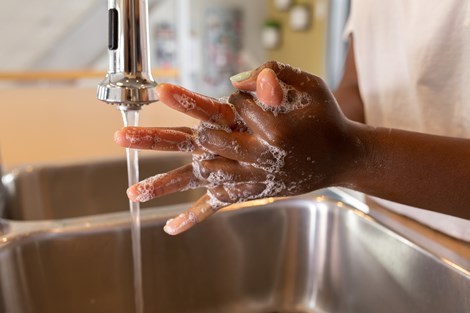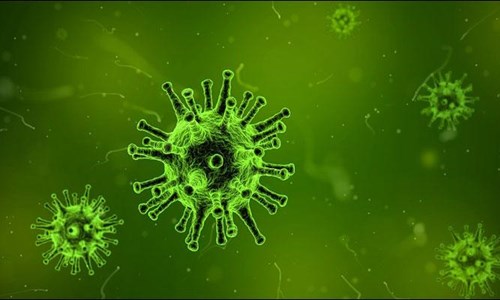
Sign in to access your HIS profile below.
 |
Hand hygiene is widely accepted to be the cornerstone of infection prevention and control (IPC): it can only be positive that awareness has been heightened during the COVID-19 pandemic. With the lack of an effective anti-viral therapy it remains an essential tool in reducing viral transmission. Helping to disseminate this important message are Public Health England’s Hands, Face, Space, Fresh Air campaign and the World Health Organization's (WHO) Safe Hands Challenge. But what evidence is there that hand hygiene is effective in our fight against COVID-19, what happens if hand hygiene is not performed and what are the challenges of ensuring good hand hygiene compliance? |
Hirose et al. demonstrated the importance of hand hygiene by showing that SARS-CoV-2 mixed in mucus can survive for 11.09 hours on human skin, suggesting this may play a role in viral transmission. Reassuringly they found it could be completely inactivated within 15 seconds by ethanol treatment. Salido et al. looked at the contamination rates of Halloween candies when handled by COVID-19 infected individuals and found that there was a marked reduction in the number that were contaminated with SARS-CoV-2 when the individuals washed their hands (60% vs 10%), and that washing the candies with dishwashing detergent reduced the viral load by 62.1%. Perhaps this study really does show if you wash your hands you can have your candy and eat it!
Whilst the above findings suggest a lack of hand hygiene may facilitate the spread of SARS-CoV-2, Meda et al. demonstrated additional negative effects when compliance is low. They attributed a reduction in hand hygiene on a COVID-19 critical care area, in addition to the use of long sleeved gowns, for an increase in nosocomial acquired gram negative infections. (You can read our blog about this here).
 |
If hand hygiene is so important why is it not universally performed at the right time every time? Whilst the facility to wash ones hands is usually taken for granted, in many parts of the world there is a lack of potable water with which to do so. Zvobgo et al. calculated that the implementation of WHO’s ‘safe hands’ challenge increased water consumption by 4.5L per person per day. In order to tackle this problem they developed a list of short and long term solutions to allow a sustainable supply of potable water during the pandemic in developing countries. |
An ongoing challenge facing IPC practitioners is ensuring that HCW regularly clean their hands. Huang et al. demonstrated that this challenge persisted during the pandemic. They used a hand hygiene recording system to measure HCW compliance on entry and exit from patient rooms. They found compliance on room entry reduced over time. However, compliance on room exit followed the epidemiology of the pandemic, increasing by 13.73% during the first wave, decreasing 9.87% during the post lock down period and then rebounding by 2.82% in the second wave. Worryingly this suggests HCW may see hand hygiene more as a means of self-protection than patient protection.
A further potential impediment to compliance is the detrimental effect increased hand hygiene can have on the hands of healthcare workers (HCW), which ultimately can impair their ability to work and may create a reluctance to regularly clean their hands. A survey of HCW by Guertler et al. at a surgical centre and intensive care unit in Germany found that hand disinfection increased from 10-20 times per day pre-COVID to 20-30 times per day during COVID (p<0.001). Despite a significant increase in hand cream application during this time symptoms of hand dermatitis were reported by 90.4%.
The existing evidence supports the use of hand hygiene in the fight against COVID-19 as well as highlighting the barriers that need to be addressed before hand hygiene compliance can be universal.
Hirose R, Ikegaya H, Naito Y, Watanabe N, Yoshida T, Bandou R et al. Survival of severe acute respiratory syndrome coronavirus 2 (SARS-CoV-2) and influenza virus on human skin: Importance of hand hygiene in coronavirus disease 2019 (COVID-19) Clin Infect dis 2020; 3:ciaa1517.
Salido RA, Morgan SC, Rojas MI, Magallanes CG, Marotz C, DeHoff P et al. Handwashing and detergent treatment greatly reduce SARS-CoV-2 viral load on Halloween candy handled by COVID-19 patients mSystems 2020;5(6):e01074-20
Meda M, Gentry V, Reidy P, Garner D. Unintended consequences of long-sleeved gowns in a critical care setting during the COVID-19 pandemic J Hosp Infect 2020;106(3):605-609
Meda M. Long-sleeved gowns and COVID-19: the unintended consequences of new PPE guidance HIS Blogs 2020.
Zvobgo L, Do P. COVID-19 and the call for ‘safe hands’: Challenges facing the under-resourced municipalities that lack potable water access: A case study of Chitungwiza municipality, Zimbabwe Water Research X 2020;9:100074
Huang F, Armando M, Dufau S, Florea O, Brouqui P, Boudjema S. COVID-19 outbreak and healthcare worker behavioural change toward hand hygiene practices J Hosp Infect 2021;111:P27-34
Guertler A, Moellhoff N, Schenck TL, Hagan CS, Kendziora B, Giunta RE et al. Onset of occupational hand eczema among healthcare workers during the SARS-CoV-2 pandemic: Comparing a single surgical site with a COVID-19 intensive care unit Contact dermatitis 2020;82(2):108-114.
If hand hygiene is so important why is it not universally performed at the right time every time? Whilst the facility to wash ones hands is usually taken for granted, in many parts of the world there is a lack of potable water with which to do so. Zvobgo et al. calculated that the implementation of WHO’s ‘safe hands’ challenge increased water consumption by 4.5L per person per day. In order to tackle this problem they developed a list of short and long term solutions to allow a sustainable supply of potable water during the pandemic in developing countries.
